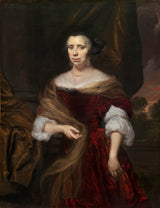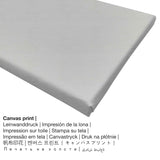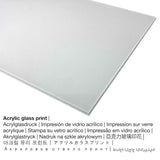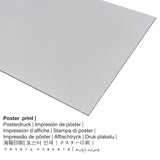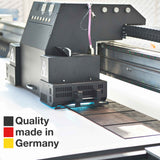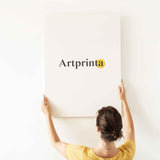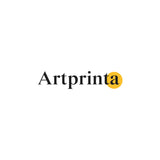Nicolaes Maes, 1676 - Eserese nwanyị - mbipụta nka mara mma
Ụtụ gụnyere. Mbupu gbakọrọ na ndenye ọpụpụ.
Nkọwapụta nka sitere na ihe ngosi nka (© Nwebiisinka - National Gallery of Art - Nnukwu osisi nke Art)
Nicolaes Maes, one of the foremost portrait painters of the second half of the seventeenth century, began his career as a painter of religious subjects and genre scenes. These early works reflect the influence of Rembrandt van Rijn (1606–1669), with whom he studied in Amsterdam between 1646 and 1653. Maes’ shift to portraiture occurred only after his return to his native city of Dordrecht in late 1653. Adopting the refined style of Anthony van Dyck (1599–1641), Maes soon began to create elegant portraits of Dutch burghers dressed in fashionable clothing that reflected their wealth and status. In search of a greater pool of patrons, he returned to Amsterdam in 1673.
Maes has portrayed this unknown matron in a rather formal pose and with a neutral expression, but he softened and enlivened her image with the loose brushwork and vibrant reds of her shimmering gown. The double strand of pearls, emblems of virtue, and her sumptuous earrings proclaim the woman’s prosperity. The broad handling, a hallmark of Maes’ style, owes much to Van Dyck’s manner of painting, but rather than idealizing the sitter as Van Dyck would have done, Maes faithfully renders her countenance. The heavy gold curtain, used as a backdrop, is another reference to material wealth, while the large column and the arcadian landscape in the distance lend the whole scene a classical air.
Overview
Ihe osise a akpọrọ Eserese nwanyị mere site na nwoke Dutch painter Nicolaes Maes. The more than 340 afọ mbụ tụrụ nha: 116 x 91 cm na arụpụtara ya na Usoro of mmanụ na kwaaji. What is more, the artwork belongs to the collection of National Gallery of Art, which is the museum of the US-American nation that preserves, collects, exhibits, and fosters an understanding of works of art. This nka ochie masterpiece, nke bụ akụkụ nke ọha na eze ka a na-enye site n'ikike nke National Gallery of Art, Washington.: . Ọzọkwa, itinye n'ọnọdụ nke mmepụta dijitalụ bụ Eserese ya na oke akụkụ nke 3: 4, nke pụtara na ogologo bụ 25% mkpụmkpụ karịa obosara. Nicolaes Maes was a painter from the Netherlands, whose artistic style was primarily Baroque. The Dutch artist lived for a total of 59 afọ a mụrụ ya n'afọ 1634 na Dordrecht, South Holland, Netherlands wee nwụọ na 1693.
Kedu ihe ebipụta nka kacha amasị gị?
Maka ngwaahịa ọ bụla anyị na-enye ihe dị iche iche dị iche iche na nha. Anyị na-ahapụ gị ka ịhọrọ nha na akụrụngwa ọkacha mmasị gị n'etiti nhọrọ nhazi ngwaahịa ndị a:
- Aluminom dibond mbipụta (ọla): Aluminium Dibond prints are prints on metal with an outstanding effect of depth. The non-reflective surface structure make a fashionable look. The Direct Print on Aluminum Dibond is the excellent start to prints on aluminum. For the Direct Aluminium Dibond option, we print your selected artwork right onto the surface of the aluminum. The bright & white parts of the artwork shimmer with a silk gloss but without the glow. The colors are luminous and vivid, the details are clear and crisp, and you can literally perceive the matte appearance of the fine art print.
- Mbipụta iko acrylic (nke nwere ezigbo mkpuchi iko n'elu): A glossy print on acrylic glass, often denoted as a an art print on plexiglass, will turn the original work of art into magnificient wall decoration and offers a distinct alternative option to canvas and aluminidum dibond art prints. The artwork is printed with modern UV print machines. This makes impressive and rich colors.
- Akwụkwọ mmado ebipụtara (akwa akwa akwa): A poster print is a printed sheet of canvas with a slightly roughened texture on the surface. A poster print is particularly suited for framing your art replica with a personal frame. Please bear in mind, that depending on the size of the canvas poster print we add a white margin of something between 2-6cm round about the work of art in order to facilitate the framing.
- Mbipụta kanvas: The canvas print is a printed cotton canvas mounted on a wooden stretcher. A canvas produces the distinctive look of three-dimensionality. Canvas Prints have the advantage of being relatively low in weight, meaning that it is easy to hang up your Canvas print without additional wall-mounts. A canvas print is suited for all kinds of walls.
Ozi ndabere izugbe gbasara onye na-ese ihe
| Aha onye nka: | Nicolaes Maes |
| A makwaara dịka: | Maes Nicolaes, Maes Nic., Nikolaus Maes, Maes, Nich. Maas, Masse, Maes Nicolas, nicolaas maas, nicol. maes, N. Mass, Maas Nicolas, Maes Nicolaas, De Maas, Maas Nicolaes, Maaes, nic. maes, N. Maus, Nicolas Maas, maes n., Nicolas Maaes, Maes Nicholas, maes nikolaes, N Maas, Mayes, nikolaes maes, nicolaus maes, Maes Nicholaes, Maas, Nicolaes mals, Nicolaus Maer, nikolas maes, C. Maes, Nic. Maas, nicholaes maes, N. Maes, nich.s maas, Maas Nicholas, Maas Nicolaas, nicolaas maes, Nicolaes Maes, Nicholas Maes, Nikolaas Maas, Nicolas Maes, maes nikolaes, Nicholas Maas, Nich. Maes, nie. maes, N. Maas, maes nicolaes |
| okike nke onye nka: | nwoke |
| Obodo onye nka: | Dutch |
| Ọrụ: | onye na-ese ihe |
| Country: | mba netherland |
| Otu nka: | nna ukwu ochie |
| Ụdị nka: | Baroque |
| Akwụsị: | 59 afọ |
| Afọ ọmụmụ: | 1634 |
| Amụrụ na (ebe): | Dordrecht, South Holland, Netherlands |
| Nwụrụ n'afọ: | 1693 |
| Nwụrụ na (ebe): | Amsterdam, North Holland, Netherlands |
Nkọwa na ọrụ nka
| Aha nke ọrụ nka: | "Ihe osise nke nwanyị" |
| Nchịkọta nke ọrụ nka: | sere |
| Otu sara mbara: | nka ochie |
| Narị afọ nka: | 17th narị afọ |
| Emepụtara n'afọ: | 1676 |
| Afọ nka: | karịa afọ 340 |
| Usoro nka izizi: | mmanụ na kwaaji |
| Nha izizi (ọrụ nka): | 116 x 91 cm |
| Ụlọ ihe ngosi nka / ebe: | Nnukwu osisi nke Art |
| Ebe ngosi nka: | Washington DC, Njikota Obodo Amerika |
| Weebụsaịtị ihe ngosi nka: | www.nga.gov |
| Ụdị ikike nka: | ngalaba ọha |
| Site n'aka: | National Gallery of Art, Washington |
Nkọwa ngwaahịa
| Bipụta ụdị ngwaahịa: | ezi nka mmeputakwa |
| Usoro mmeghari: | dijitalụ mmeputakwa |
| Produzọ mmepụta: | mbipụta dijitalụ |
| Ihe ngosi: | emere na Germany |
| Ụdị ngwaahịa: | na mmepụta ihe |
| Ojiji ngwaahịa: | foto mgbidi, ụlọ mmepụta nka nka |
| Ntuziaka onyonyo: | usoro eserese |
| Ụdị anya: | 3: 4 |
| Pụtara nke akụkụ akụkụ: | ogologo bụ 25% mkpụmkpụ karịa obosara |
| Ngwa ngwaahịa dị: | akwụkwọ mmado (akwụkwọ kwaaji), mbipụta enyo acrylic (nke nwere ezigbo mkpuchi iko), mbipụta ọla (aluminium dibond), mbipụta kwaaji |
| Nha n'arọwa n'elu ihe ndọtị (mbipụta akwa akwa): | 30x40cm - 12x16", 60x80cm - 24x31", 90x120cm - 35x47", 120x160cm - 47x63" |
| Mbipụta iko acrylic (nke nwere ezigbo mkpuchi iko): | 30x40cm - 12x16", 60x80cm - 24x31", 90x120cm - 35x47", 120x160cm - 47x63" |
| Nhọrọ nha nke akwụkwọ mmado (akwụkwọ kwaaji): | 30x40cm - 12x16", 60x80cm - 24x31", 90x120cm - 35x47" |
| Nhọrọ nha mbipụta aluminium dibond: | 30x40cm - 12x16", 60x80cm - 24x31", 90x120cm - 35x47" |
| ụba: | oyiri nka na-enweghị isi |
Nkwupụta iwu: We try what we can in order to describe the art products as accurately as it is possible and to exhibit them visually. Nonetheless, the colors of the print products, as well as the printing can vary marginally from the presentation on the device's monitor. Depending on the screen settings and the condition of the surface, colors can unfortunately not be printed one hundret percent realistically. Considering that all are printed and processed by hand, there may as well be slight deviations in the motif's exact position and the size.
Copyright right, www.artprinta.com (Artprinta)

